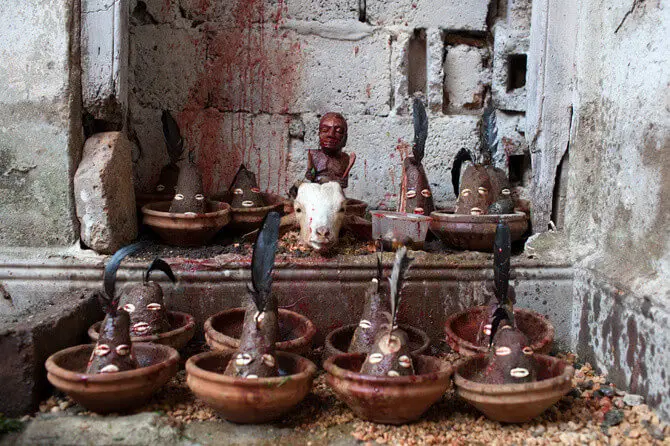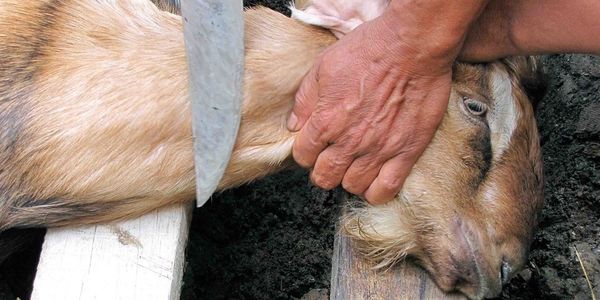If you live in the southern part of Florida, you are probably aware of the infamous Santeria belief system.
Despite being similar in many ways to orthodox Christianity, it has strange rituals that are uncommon in the Christian faith. The common one is sacrificing animals.
Animal sacrifice is no doubt at the center of Santeria. The followers of the religion often hold large celebrations that involve slitting the throats of chickens, goats, turtles, and other animals.
Ever wondered what that’s all about? Here’s a guide that discusses the practice in detail.
Why Do Santeria Sacrifice Animals?
The Santeria religion can be defined as a mix between the Roman Catholic faith and old Yoruba traditional religious practices.
The latter religion was introduced to Cuba and essentially the new world during the Atlantic slave trade.
The Yoruba people from West Africa brought their practice with them when they were shipped overseas as slaves.
During the Cuban Revolution, the religion spread to the United States. It is now rampant in South Florida.
Santeria is Spanish for “the way of saints”. The religion worships a god called Olodumare who is considered the owner of all destinies.
However, Yorubans have relationships with over one thousand spiritual beings referred to as orishas.
These deities serve as intermediaries between people and the physical world and the creator (Olodumare).
This is where animal sacrifices come in. Santeria followers ideally offer animal blood to orishas as a way to feed them.
Without the blood, the gods will essentially die and the religion will follow suit.
Olodumare is also manipulated with animal blood offerings. The ritual is done by slaughtering animals in elaborate ceremonies mostly during birth, weddings, and death.
When an individual is being initiated into the faith, sacrifices are also offered to the spirits.
Additionally, sacrifices are done to share a meal with the orishas. The followers of the faith believe that the gods only take blood.
The meat from the animals is consumed by the temple members. By feeding the orisha, the relationship between the follower and the orisha is strengthened. The ritual also makes the latter aware of the spirit’s presence.
During the sacrifice, a priest or priestess nips the animal’s carotid artery with a knife stroke. For chicken, the head is almost always cut out.
Once the blood has been spilled, the animal is then cooked and eaten by the followers of the faith.
It is only during death and sickness rituals that the animals aren’t consumed as it is believed that the death or illness is passed to the animals being sacrificed.
Also check: Is Santeria Witchcraft?
Animal Sacrifices and Their Meanings

Santeria church followers sacrifice different animals. The most common are goats and chickens, but turtles, sheep, doves, guinea pigs, ducks, and pigeons can be offered as well.
Here are some of the common ones and their meanings.
1. Santeria Chicken Sacrifice Meaning
Roosters are more common in Santeria animal sacrifices than any other animal.
Jose Ortiz, one of the many committed Santeria followers explains that decapitated chicken sacrifices are performed to rid the body of an illness, curse, or to prepare for a legal battle.
2. Santeria Goat Sacrifice Meaning
Goats come in a close second to chickens as far as Santeria animal sacrifices go.
Sometimes both animals are sacrificed in one single celebration.
According to Channel 3 News, goat sacrifices are meant to catch the attention of the religion’s warrior god.
People looking for protection for their families offer goats to orishas to get the warrior god to fight for the said family.
In some instances, goats represent Oya who is considered the ruler of the cemetery and justice.
Orishas are also known to choose other animals for one reason or the other.
Priests and priestesses are responsible for asking the deities the animals they require during the ritual.
Sometimes, the spirits choose sheep, turtles, doves, pigeons, and more.
The deities typically give the minimum requirements. Chicken and goats are considered strong animals which cannot be rejected by the spirits.
Is Animal Sacrifice Legal In The Context Of Santería?
Initially, the US government was adamant about animal abuse including during religious animal sacrifices.
The Supreme Court upheld the church’s right to kill animals stating that the only acceptable murder of animals was for food consumption. Any other was considered abuse and thus prohibited.
The church fought back in 1993 arguing that the practice is part of its religions.
In the same year, the U.S. Supreme Court ruled that animal sacrifice is Santeria’s protected religious sacrament in the Church of Lukumi Babalu Aye, Inv. v. city of Hialeah. Now, the practice is legal in the United States.
How do adherents of Santería justify animal sacrifice in their beliefs?
Based on Santeria teachings, followers of the Santeria religion argue that orishas depend on animal blood to survive.
They further state that the spirits are only powerful but not immortal.
If they don’t get enough food, they will die and take their religion along with them.
Are there any regulations or guidelines surrounding Santería animal sacrifices?

After winning the legal battle against the prohibition of animal sacrifices, the Santeria church pretty much does what it pleases during animal sacrifice rituals.
There are no specific laws that guide them on how to conduct the exercises.
That means they have the liberty to kill the animals using any means they deem fit.
The temple members also decide where the carcass is disposed of.
In several instances, decapitated chickens have been found in trash bags and random places by different groups of people.
Iohud reported finding of 25 chicken carcasses dumped in garbage bags somewhere along Firemen’s Memorial Drive.
Besides several breeds of chicken, the bags also contained guinea hens, a pygmy goat, pigeons, and other birds.
It is clear that the U.S. authorities have turned a blind eye to the subject after the 1993 ruling on religious animal sacrifices.
What are some common misconceptions or misunderstandings about Santería animal sacrifice?
Santeria is a largely misunderstood religion. Here are some of the misconceptions surrounding the faith.
- The religion is similar to voodoo: The two are very different from each other
- Santeria is polytheistic: There’s only one true god with thousands of deities.
- Santeria can be easily learned: The religion has hierarchies and elaborate initiation ceremonies conducted by trained priests
- Animal sacrifices are frequent: Besides animal sacrifices (which are rare), the religion also gives other gifts such as fruits, glasses of water, candles, coins, and grains.
- Santeria makes use of catholic saints: There’s a clear demarcation being catholic priests and Santeria priests.
Wrap Up
Santeria is big on animal sacrifice. From birth to weddings to healing ceremonies and death ceremonies, the religion slaughters all kinds of animals to feed the spirits and get the creator to pay attention to them.
The spirits only require animal blood for their survival.
The meat can be cooked and eaten among the followers.
Strange, no doubt but the practice is legal in the United States.



